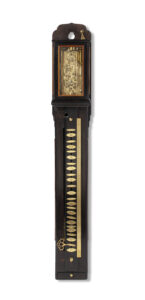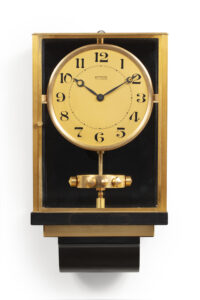WALL CLOCK Goslink Ruempol Laren dated 1727 Holland
M&R140
WALL CLOCK
Signed: Goslink Ruempol Laren
dated 1727
Holland
Movement
The 12-hour, weight-driven two-train birdcage movement of this typical Ruempol clock has iron top and bottom plates, connected by shaped brass pillars. It has going and striking trains, constructed between vertical bars. The going train has a vertical verge escapement and pendulum, whilst the Dutch striking train indicates the hours and half hours fully on a bell. In addition, the clock has an alarm, situated in front of the going train.
Dial
The painted iron dial has a chapter ring with Roman numerals with half-hour, quarter-hour and Arabic five-minute divisions against a black background. The maker has signed the clock above the chapter ring: Goslink Ruempol Laren and dated beneath the ring 1727. The time is indicated by a cast-brass hour hand and an iron minute hand. In the middle is an alarm disc with holes, which is an integral part of the hour hand. To set the alarm a threaded pin can be screwed in one of the holes, marked by Roman numerals.
Case
The movement is housed in an iron case with glazed doors to the sides, through which the movement is visible. The doors are surmounted by gold-leaf covered pierced lead frets depicting two lions with a coat of arms. There is also such a fret above the dial depicting the cornucopia flanked by two putti. The case rests on four sturdy ball feet on a bracket. This bracket forms part of an oak construction, the so-called stool. The whole is surmounted by a gable-shaped top.
Duration 12 hours
Height 73 cm
Width 37 cm
Depth 31 cm
Literature
– E Morpurgo, Nederlandse Klokken- en Uurwerkmakers vanaf 1300, Amsterdam, 1970, p. 109.
– J. Zeeman, De Nederlandse Stoelklok, Assen/Amsterdam, 1978, Ch. 9 (p.155 ff.).
The maker
Goslinck (Gosselijkck) Ruempol was baptised in Laren (Gelderland, in the east of the Netherlands) in 1682. He was married in 1712. He was active as a clockmaker in Laren from c. 1736 and became famous as such and the father of a clockmakers family. His sons and grandsons made clocks in the same style. These clocks share aspects with Zaandam and Friesland clocks. Most of them are characterised by the gable-shaped roof of the stool and were much sturdier made than their counterparts made elsewhere. They invariably have verge escapement and a painted dial. The doors and the case are attractively painted and the ornaments show quality. His son was called Hendrik Ruempol, his three grandchildren Hendrik Jan, Harmen and Hendrik Gerrit Ruempol. His surname was Koeslag, but in 1710 he bought a farm called ‘Den Ruempol’ in Lochem, since then the family adopted the name Ruempol. He signed his clocks Goslinck Ruempol Laren. He died in 1759














